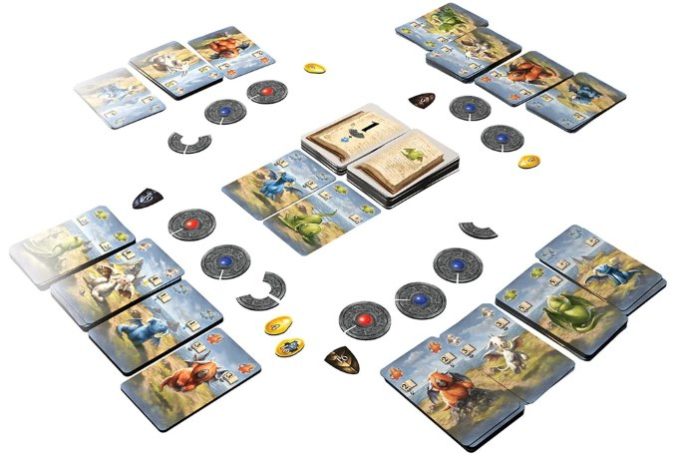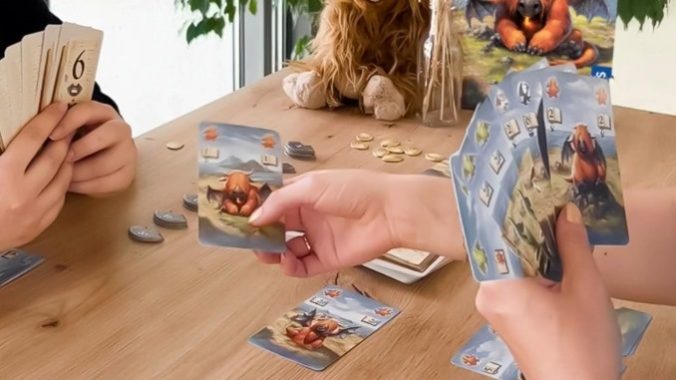Dragonkeepers, a buzzy game at last year’s PAX Unplugged, was designed by Michael Menzel (Legends of Andor, The Adventures of Robin Hood) with extremely cute artwork and a short rulebook. Maybe I set my expectations too high, but I don’t think this game works at all, not as a kids’ game, which appears to be the target audience, and certainly not as a game for anyone older than that.
Dragonkeepers has two decks of dragon cards that you’ll shuffle separately and that, when placed face-down next to each other, show the left and right pages of an open book, with a number on the left and a dragon color on the right. That combination indicates the number of dragon cards of that color that a player can play on their next turn. The combination will change, however, as the player draws cards. There are always two cards in front of the decks, one from each pile, and you replace them immediately when either is taken. Once the player has taken anywhere from one to three cards (or a fourth with a bonus), they must play cards matching the requirements shown on the book—or they may play one or two cards from their hand to the tops of the deck to change the combination to something they would prefer to play instead.
You play those dragon cards to stacks in front of you, sorted by color, so with four colors of dragons in the game you will end up with no more than four stacks. You can only have two active stacks, however: the ones at the left and right ends of your row of stacks. Once any stack has others to the left and right of it, it’s closed, and you can no longer play dragons of that color for the remainder of the game. You do get a bonus if you’re the first, second, or, in a three to four player game, the third player to play a dragon of each color.

When you play any number of dragons, you get an amulet fragment with a point total written on it; every three fragments completes an amulet, after which you get to claim a face-down pearl token for another bonus. The amulet fragments’ value increases as the game progresses from 1 to 20 points, while the first few pearls available are worth 8 or 9 points, after which they’re worth no more than 4. (Just go with it.) Most of the time that you play a dragon, you’ll get an additional bonus, shown on the top card on the left ‘page’ of the book. Sometimes you get another amulet fragment, and rarely you get to take the most valuable amulet fragment left rather than the default of the least valuable one. You might get a crystal, which you can use in a later turn to take a fourth card. You may also get an egg token, worth 4 points on its own, while the player with the most egg tokens at the end of the game gets to flip one to make it worth 16 points rather than 4. And there are “shadow” dragons you can get as bonuses, which can be used as a wild dragon of any color, or can be played to the left deck for their value of 6.
I was dismayed to find how little game there really is under the hood here. The card-selection mechanic is very similar to that of Welcome To, except for the way you can sort of manipulate the action you take—but that is so restricted by luck that it’s often useless. You can’t see what cards are coming up in either deck, unlike in Welcome To, so drawing another card to try to create a more favorable combination is like buying a lottery ticket (without being a giant tax on the poor). The fact that you get an amulet piece every time you play cards, regardless of whether you play one or the maximum of six, also never sat right; it’s like a participation trophy, sort of, and the points just keep getting higher as the game goes on. There’s a huge amount of randomness in Dragonkeepers, and not much room for strategy, even from one turn to the next.
There’s also the problem of closing off up to two colors of dragons as the game progresses, which means that you have fewer options later in the game, and that’s just bad in a game that claims to be good for players ages eight and up. One of the things I dislike most in game design is when a game makes it possible for a player to have a turn where they can’t do anything, and Dragonkeepers makes that way too easy because of that mechanic. When I played with my seven-year-old I had to do some Candyland-style shenanigans (where I would shout “Look over there!” and move cards in the deck so the game would end) to avoid her ending up with a turn where she couldn’t play a card. I promise you, no one enjoys a game where they end up stuck, even for a turn. The game is quick, easily under 30 minutes, but the rules here aren’t that easy for a younger player to grasp, the scoring is kind of nonsensical, and it’s way too easy to have a bad turn. Board games can be intense and strain your brain, but they still have to be fun.
Keith Law is the author of The Inside Game and Smart Baseball and a senior baseball writer for The Athletic. You can find his personal blog the dish, covering games, literature, and more, at meadowparty.com/blog.

